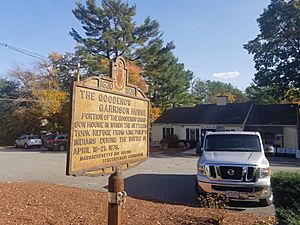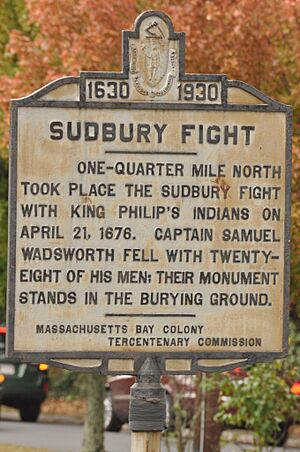Sudbury Fight facts for kids
Quick facts for kids Sudbury Fight |
|||||||
|---|---|---|---|---|---|---|---|
| Part of King Philip's War | |||||||
|
|||||||
| Belligerents | |||||||
| Wampanoag Nipmuc Narragansett |
|||||||
| Commanders and leaders | |||||||
| Samuel Wadsworth † Samuel Brocklebank † Hugh Mason Edward Cowell John Sharp † Solomon Phipps |
Possibly Metacomet or Muttawmp (see Background) | ||||||
| Strength | |||||||
| 120 infantry 40 cavalry 80 civilian volunteers |
500 | ||||||
| Casualties and losses | |||||||
| 74 | 120 | ||||||
The Sudbury Fight happened on April 21, 1676. It was an important battle during King Philip's War. This fight took place in what we now call Sudbury and Wayland, Massachusetts.
About 500 Wampanoag, Nipmuc, and Narragansett Native American warriors attacked the town of Sudbury. This town was a frontier settlement in the Massachusetts Bay Colony. English soldiers, called militiamen, came from nearby towns to defend Sudbury. However, two groups of these soldiers were caught in Native ambushes. They lost many men.
The Sudbury Fight was the last big victory for Native Americans in King Philip's War. The war ended a few months later in August 1676, when the Native forces were finally defeated in southern New England.
Contents
Why the Fight Happened
The winter of 1676 was quiet during King Philip's War in eastern Massachusetts. But when spring came, Native American forces started raiding towns again. These towns were settled by Puritan colonists.
The Native American groups attacked a fort in Marlborough, Massachusetts twice. They attacked on March 16 and again on April 7. They destroyed most of the town. Many people had to leave their homes. Because of these attacks, and because other towns like Lancaster and Groton had been left empty, the colonial leaders sent help.
Captain Samuel Wadsworth and fifty men were sent to Marlborough to protect the frontier. Wadsworth's group passed through Sudbury on the evening of April 20.
Meanwhile, a large group of Native warriors gathered at Pompositticut Hill. This hill is now in Maynard, Massachusetts. After a meeting, they decided to attack Sudbury instead of Concord. Some people believe that Metacomet, a famous Native leader, led the army at Sudbury. However, old records do not clearly say this. Some historians think that a Nipmuc leader named Muttawmp was in charge.
The Battle Begins
Native American forces secretly entered Sudbury during the night. They attacked at dawn. They burned houses and barns. They also killed several people. Many English residents of Sudbury lived on the east side of the Sudbury River. They left their homes and found safety in fortified houses called garrison houses.
The Native forces surrounded the Haynes garrison house. They attacked it all morning. But the English civilians inside defended it strongly. At one point, the Native warriors rolled a burning cart full of flax down a hill towards the garrison. But the cart hit a rock and spilled before it could cause any damage. The Haynes garrison held strong throughout the battle. Some historians think this attack was a trick to bring more English soldiers to the area.
Ambush at Old Town Bridge
When people in Concord heard the alarm, about a dozen men marched to help Sudbury. But they were ambushed and killed. The people defending the Haynes garrison could see what was happening. Only one of the Concord men escaped. The dead were buried in a mass grave east of Old Town Bridge in Wayland.
After this victory, the Native forces crossed the river. They began to take things from the main part of Sudbury. Shortly before noon, English soldiers from Watertown arrived. They were led by Captain Hugh Mason. They successfully pushed back the raiding party.
Wadsworth's Last Stand
While Mason was taking back control of the town, Captain Wadsworth arrived from the west. He had about seventy men. His group was joined by Captain Samuel Brocklebank's soldiers from Marlborough. Wadsworth's men had only rested a short time in Marlborough. They were hungry and tired as they marched back to Sudbury. They did not know where the enemy was.
About a mile from town, Wadsworth's men saw about a hundred armed Native warriors running into the woods. The soldiers thought they could easily defeat them. So, the militia chased after them.
The Native warriors led the soldiers to a low area between Goodman's Hill and Green Hill in Sudbury. There, they set a trap. They surrounded the small English force. Wadsworth fought his way to the top of Green Hill. He told his men to form a square, and they fought off many Native attacks. The fighting continued all afternoon.
The Watertown militia and two groups of English cavalry tried to rescue Wadsworth. But they could not break through the Native forces. They were forced to retreat.
Native warriors then set fire to the dry brush on the hill. The smoke choked Wadsworth's tired group. In a panic, the English soldiers broke formation and ran. Half of the soldiers were killed as they fled. This included Wadsworth and Brocklebank. The survivors ran south towards the Goodenow garrison house. Mason's group and the cavalry were gathering there. Thirteen or fourteen soldiers also found safety in the fortified Noyes grist mill. They were rescued later.
Some historical accounts say that the Native warriors took "five or six of the English alive." One historian claimed English captives were tortured. However, Mary Rowlandson, who was a captive of a Native leader named Weetamoo and was present during the battle, does not mention torture in her writings.
What Happened After
As night came, Native forces left Sudbury. Early the next day, English soldiers and a group of allied Praying Indians went to the battlefield. They buried the dead.
Mary Rowlandson said that even though the Native forces won, they were not happy after the Sudbury Fight. She wrote that they came home "without that rejoicing and triumphing over their victory." She thought they were sad, "like dogs (as they say) which have lost their ears." She also said, "They said they had not lost above five or six."
Other historians, like Hubbard and Mather, disagreed. They said the Native forces lost about "a hundred and twenty" men. In the fall of 1676, important people from Sudbury said they had killed "a considerable slaughter" of Native attackers. On the morning of April 22, Native warriors shouted seventy-four times to English soldiers in Marlborough. This was to show how many enemies they believed they had killed at Sudbury.
Remembering the Battle
In 1730, Samuel Wadsworth's son, Benjamin Wadsworth, placed a memorial stone. It was put over the mass grave where his father and his men were buried. Benjamin Wadsworth was the president of Harvard College at that time. In 1852, the remains of Wadsworth's soldiers were dug up. They were reburied fifty feet north at the site of a new monument. This new monument is near Green Hill.
Both memorials incorrectly say the battle happened on April 18. This was probably a mistake made by a historian that was copied later. The correct date is April 21. A letter from April 21, 1676, from the Massachusetts Bay government to the governor of Plymouth Colony states, "This day we have intelligence in the general that Sudbury was this morning assaulted and many houses burnt down."
There are a few other monuments and markers in Sudbury and Wayland that remember the Sudbury Fight. Most of these were put up in the 1930s. This was to celebrate Massachusetts's 300th anniversary. Today, the battlefield around Goodman's Hill and Green Hill is a wealthy residential area.
See also
 In Spanish: Batalla de Sudbury para niños
In Spanish: Batalla de Sudbury para niños



